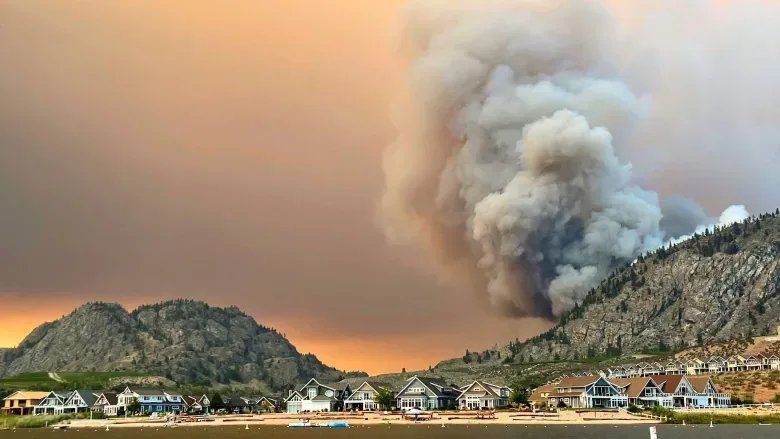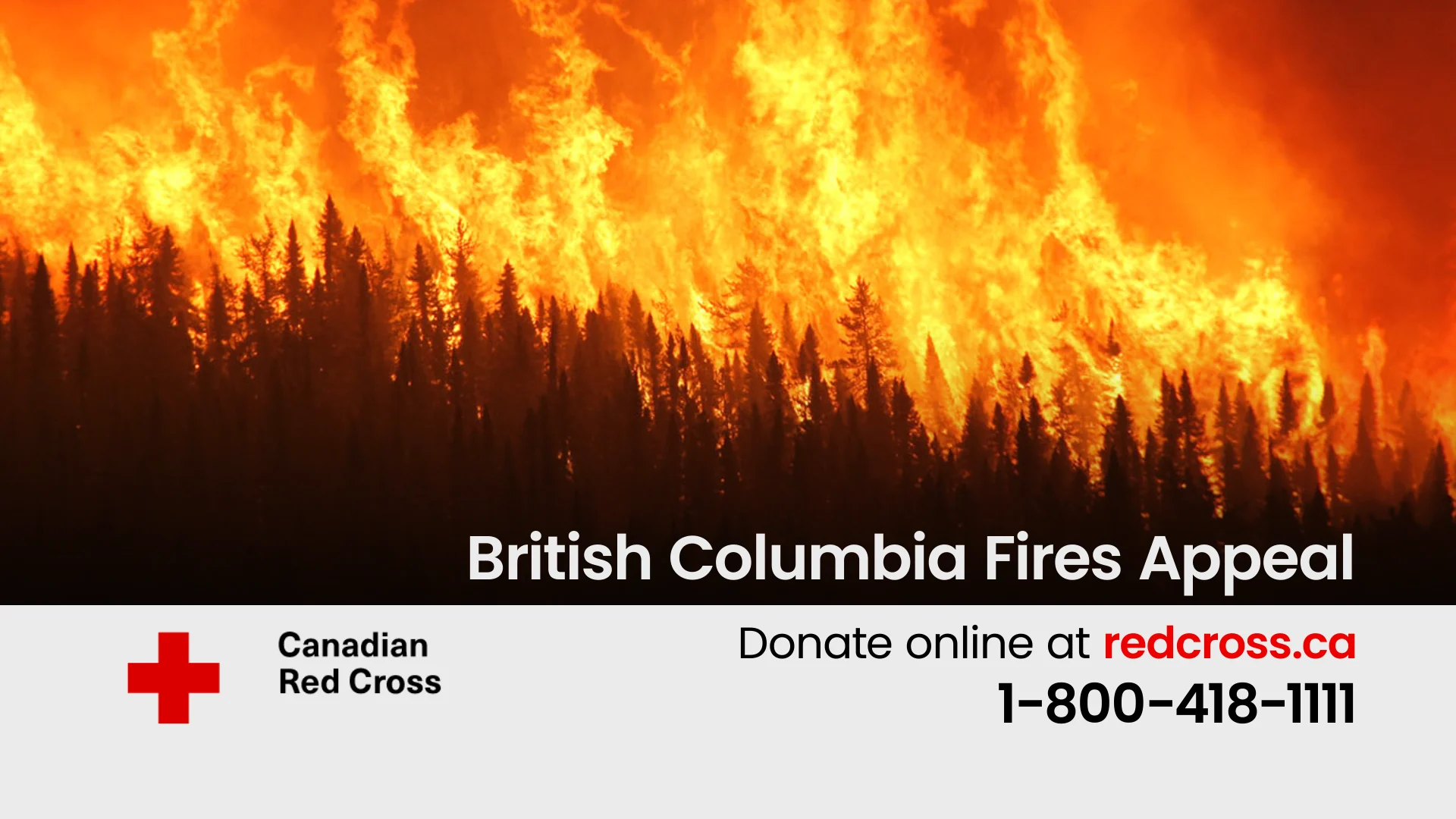
Wildfire between Oliver and Osoyoos grows, evacuation orders issued
A provincewide state of emergency has been declared in B.C. as wildfires continue to grow, forcing hundreds from their homes and putting thousands more on evacuation alert.
Public Safety Minister Mike Farnworth said the declaration will help deal with the mass evacuations quickly and allow the government to secure accommodation for those people if necessary.
As of Tuesday afternoon, there were more than 2,860 properties on evacuation order provincewide. An additional 16,038 properties are under evacuation alert across the province.
"We have reached a critical point," Farnworth said.
More than 3,000 square kilometres of land have been burned by 1,145 wildfires in B.C. this season so far, which is three times the 10-year average for this time of year, according to B.C. Wildfire Service director of operations Cliff Chapman.
The state of emergency will stay in effect for 14 days but may be extended as needed.

NK'MIP CREEK FIRE MORE THAN DOUBLES IN SIZE
A provincial state of emergency has been declared in B.C. as wildfires continue to grow, forcing hundreds from their homes and putting thousands more on evacuation alert.
The Nk'Mip Creek fire continues to burn on Osoyoos Indian Band land between the towns of Oliver and Osoyoos, about 40 kilometres south of Penticton. The BC Wildfire Service had previously referred to the fire as the Inkaneep Creek wildfire, but changed the name on Tuesday.
As of 10 a.m. PT, the fire was estimated to cover 11 square kilometres — almost three times the size of Vancouver's Stanley Park and an increase from seven square kilometres on Monday night.
Those fighting the fire Tuesday are up against unrelenting wind, which has been blowing flames across tinder-dry terrain.
MUST SEE: Canada covered by smoky skies as nearly 800 active wildfires burn
"Crews have been quite challenged by these steady winds," said Taylor MacDonald with the B.C. Wildfire Service.
The Oliver Fire Department posted a brief video Tuesday showing the fire in its early stages. The post said crews worked in shifts through the night to protect buildings from the flames.

A picture of the Inkaneep Creek wildfire from Oliver, B.C. (James Moore)
IMPORTANT: Expert tips on how to cope with wildfire smoke
FRANTIC EVACUATIONS
Hundreds of people were ordered to evacuate properties Monday after the wildfire exploded in size.
Geraldine and Rod Foley fled their home near Mount Baldy, in rural Oliver, with a few treasured photos and their pets: eight dogs, two cats and two parrots.
"From our balcony, you could see the smoke. It was horrendous. Then all of a sudden, within five minutes, the flames were just booming up in the air," Rod said Tuesday.
A regional official "walked up the hill and yelled, 'You gotta go, now,'" he said.
Geraldine took half the animals with her in the truck, and Rod rode behind with the other half inside the couple's motorhome, where they plan to stay.
Geraldine said her son, a firefighter, told her they could be in danger of losing the home to the fire if the wind shifts.
WATCH BELOW: HOW TO PROTECT YOURSELF FROM WILDFIRE SMOKE
"It makes me want to cry," Geraldine said. "That's my home."
The wildfire quickly grew from 0.03 square kilometres to more than three over the course of a few hours Monday afternoon. It was seven square kilometres as of 9 p.m. PT.
Evacuations happened so frantically that officials haven't been able to confirm exactly how many people are out of their homes.
"The total number [of evacuees], I haven't had a chance to add up," Erick Thompson, an information officer with the Regional District of Okanagan-Similkameen (RDOS), said in an early-morning interview.
The Oliver-Osoyoos region is a popular tourist destination, known for its wineries. The legion hall in Oliver was opened Tuesday morning as a reception centre for evacuees.
All evacuees are asked to register online with Emergency Support Services (ESS), even if they don't need referrals for assistance such as housing.

The Inkaneep Creek wildfire is about six kilometres north of Osoyoos, B.C., on Osoyoos Indian Band land. (B.C. Wildfire Service/Twitter)
Despite the fire's growth, the mayor of Oliver said crews who worked on the fire overnight appear to have made progress.
"Just visually, from what I can see, things do look a lot better. The wind definitely did not come up, but the fire was quite visible overnight in certain areas for sure," Mayor Martin Johansen told CBC News on Tuesday.
"I believe, you know, we've kind of gotten through maybe the initial worst of it. We'll see where it goes today … everything was put on this fire as quickly as possible."
The first evacuation order, covering almost 200 properties, was issued by the Osoyoos Indian Band on Monday evening.
Chief Clarence Louie with the Osoyoos Indian Band said the Oliver Fire Department did an "outstanding job" to save houses closest to the fire.
Members of the band who evacuated are staying in hotels in the Oliver-Osoyoos area for the time being, he said. Some have elected to stay behind.

Flames from a B.C. wildfire can be seen on the hills behind cottages in Oliver, B.C. (Anita Bathe/CBC)
Meanwhile, the RDOS has an evacuation order in place for several dozen properties east of the wildfire.
Further to the order, several dozen properties in the region — as well as within the town of Oliver — are under evacuation alert and are being asked to prepare to leave if an order is issued.
The RDOS has declared a local state of emergency. The town of Oliver, which has a population of about 5,000, has also declared a local state of emergency.
In the North Okanagan, near Vernon, more than a dozen properties were ordered evacuated on Tuesday due to a wildfire on the east side of Mabel Lake.
EVACUEES STRUGGLE TO FIND ACCOMMODATION
This fire is among the hundreds of wildfires currently burning across B.C., including more than 100 wildfires concentrated in the Interior. As of Monday, there were more than 2,570 properties on evacuation order province-wide.
Residents under evacuation have been scrambling to find safe accommodations, with hotel rooms at a premium.
Thompson-Nicola Regional District chair Ken Gillis said there are no available places to stay in Kamloops, Merritt or Salmon Arm.
"They're absolutely full," he said.
The RDOS encouraged evacuees to consider making arrangements to stay with family or friends due to the shortage of hotel accommodations. The district also called on tourists to be cognizant of the wildfire situation around them before heading into the area.
"Certainly, the message from anyone who is involved in tourism is that this region is still open for business … the issue is, with fast-moving wildfires, anyone who is scheduled to be in this area or who is visiting has to be very situationally aware," said Thompson, with RDOS.
"The Okanagan is complex in that way now."
An additional 15,685 properties are under evacuation alert across B.C.

WEATHER 'A HUGE CONCERN'
The weather in the Interior is also challenging for fire crews. There was no rain in the southern half of the province over the weekend, and some areas haven't seen rain for nearly five weeks.
Conditions are expected to stay hot and bone-dry through the week.

"The weather is a huge concern and we're only in the middle of July. This is our second, third fire in this region. I won't be surprised if we get more," said Johansen, the mayor of Oliver.
"I just hope everybody does everything they can to be safe and do everything they can to avoid, you know, accidentally creating any fires … We're all very concerned and we've got a long road ahead."
Anyone placed under an evacuation order must leave the area immediately.
Evacuation centres have been set up throughout the province to assist anyone evacuating from a community under threat from a wildfire. To find the centre closest to you, visit the Emergency Management B.C. website.
Evacuees are encouraged to register online with Emergency Support Services, whether or not they access services at an evacuation centre.
*This article was originally published by CBC News. Contains files from Roshini Nair, Eva Uguen-Csenge, Meera Bains, Courtney Dickson and The Canadian Press.
Visit www.airhealth.ca for information on how to reduce your health risk and your personal contribution to pollution levels, as well as for current and forecast AQHI values.









